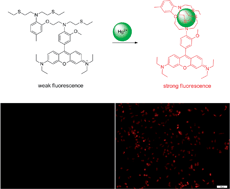A rhodamine-based fluorescent sensor for the highly selective and sensitive detection of mercury in aqueous solution and living cells†
Abstract
A novel Hg2+-selective fluorescent sensor (Sensor-Hg) based on a rhodamine scaffold, with N-Ethylthioethyl-N-[N′,N′-(2′-Diethylthioethylamino)-5′-methyl-Phenoxyethyl]-2-Methoxy Aniline (EDPMA) as a receptor, has been developed. Sensor-Hg exhibited ∼35-fold enhancement in fluorescence emission upon binding with Hg2+, with a characteristic emission band of rhodamine at ∼585 nm. It demonstrates high selectivity and sensitivity for detecting Hg2+ in aqueous solution and living cells.


 Please wait while we load your content...
Please wait while we load your content...